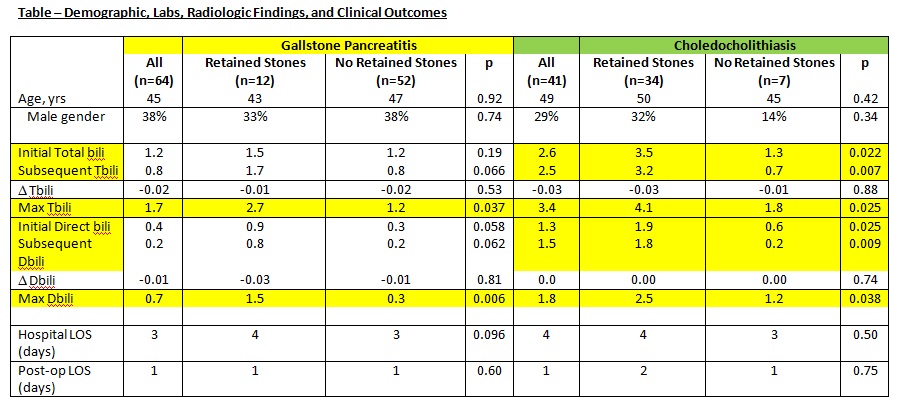D. D. Yeh1, P. Fagenholz1, N. Chokengarmwong1, Y. Chang1, K. Butler1, H. Kaafarani1, D. R. King1, M. DeMoya1, G. Velmahos1 1Massachusetts General Hospital,Trauma, Emergency Surgery, And Surgical Critical Care/Department Of Surgery/Harvard Medical School,Boston, MA, USA 2Massachusetts General Hospital,Department Of Medicine,Boston, MA, USA
Introduction: Gallstones escaping the gallbladder into the common bile duct (CBD) can cause complications such as pancreatitis or biliary stasis with risk of cholangitis. Evaluation for and treatment of retained CBD stones may be performed using pre- or post-operative endoscopic retrograde cholangiopancreatography (ERCP) or intra-operative cholangiogram (IOC). Ideally, these investigations should be limited to only cases with high pre-test probability of retained stones, as routine investigation may result in unnecessary procedures and prolonged hospitalization. We hypothesized that initial levels and trends in serum bilirubin levels are predictive of diagnostic yield of CBD investigations in patients presenting to the Emergency Department with evidence of gallstone pancreatitis (GP) or choledocholithiasis (CDL).
Methods: We performed a retrospective analysis of a prospectively collected registry of all patients undergoing cholecystectomy for GP or CDL by the Acute Care Surgery team at our academic, tertiary hospital from June 2010 to January 2014. Demographic, laboratory, radiologic, and operative data were collected. Patients were divided into groups according to diagnosis and whether or not they had retained CBD stones on ERCP or IOC. Summary statistics were used to describe continuous variables and compared with Wilcoxon rank sum, while proportions were calculated for categorical variables and compared with chi square. Statistical significance was defined as two-sided p<0.05.
Results: 64 patients underwent cholecystectomy for GP and 49 patients underwent cholecystectomy for CDL. Overall rate of retained CBD stones was low for GP and high for CDL (22% vs. 81%, p<0.001). For GP, the maximum total bilirubin (TB) and max direct bilirubin (DB) values were significantly different between patients with and without retained stones (Table). For CDL, initial TB, subsequent TB, max TB, initial DB, subsequent DB, and max DB were significantly different between groups (Table). Hospital and post-op LOS were not significantly different.
Conclusion: For GP and CDL, initial levels and trends in serum bilirubin levels are significantly different between patients with and without retained stones on CBD investigation. These labs may be useful in predicting if a CBD stone has already passed and whether or not CBD investigation will be worthwhile time, effort, and complication risk.
